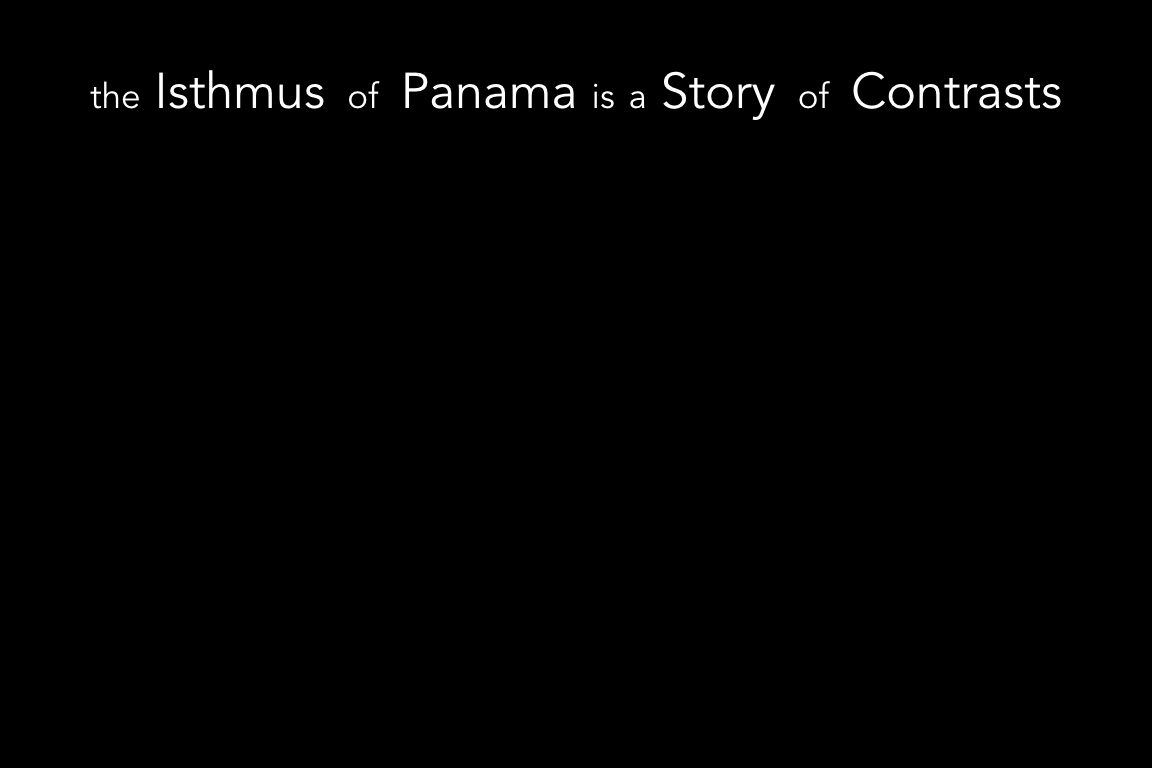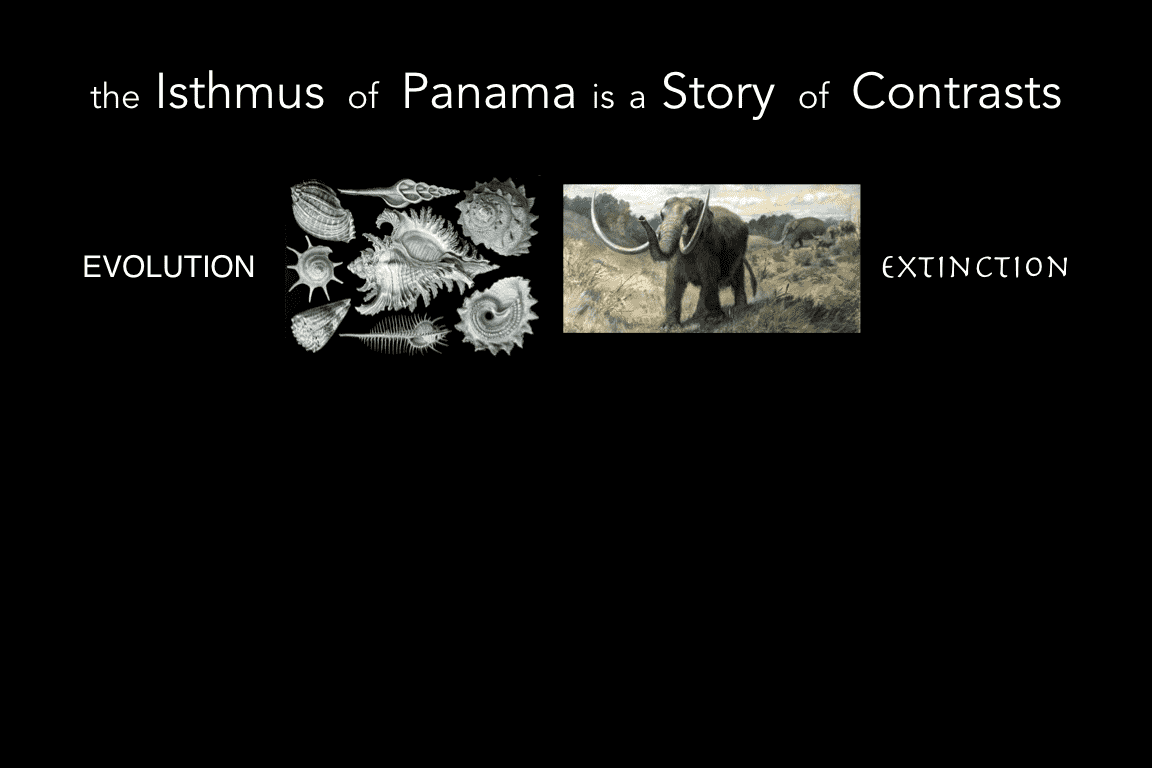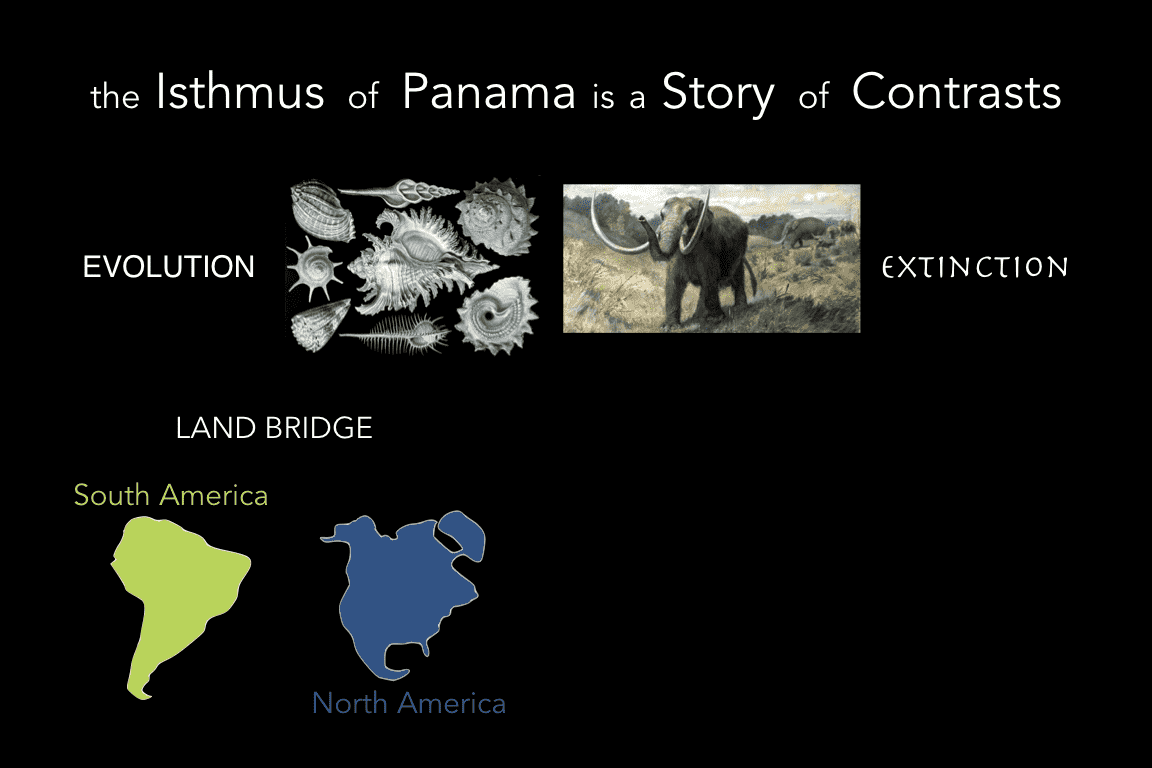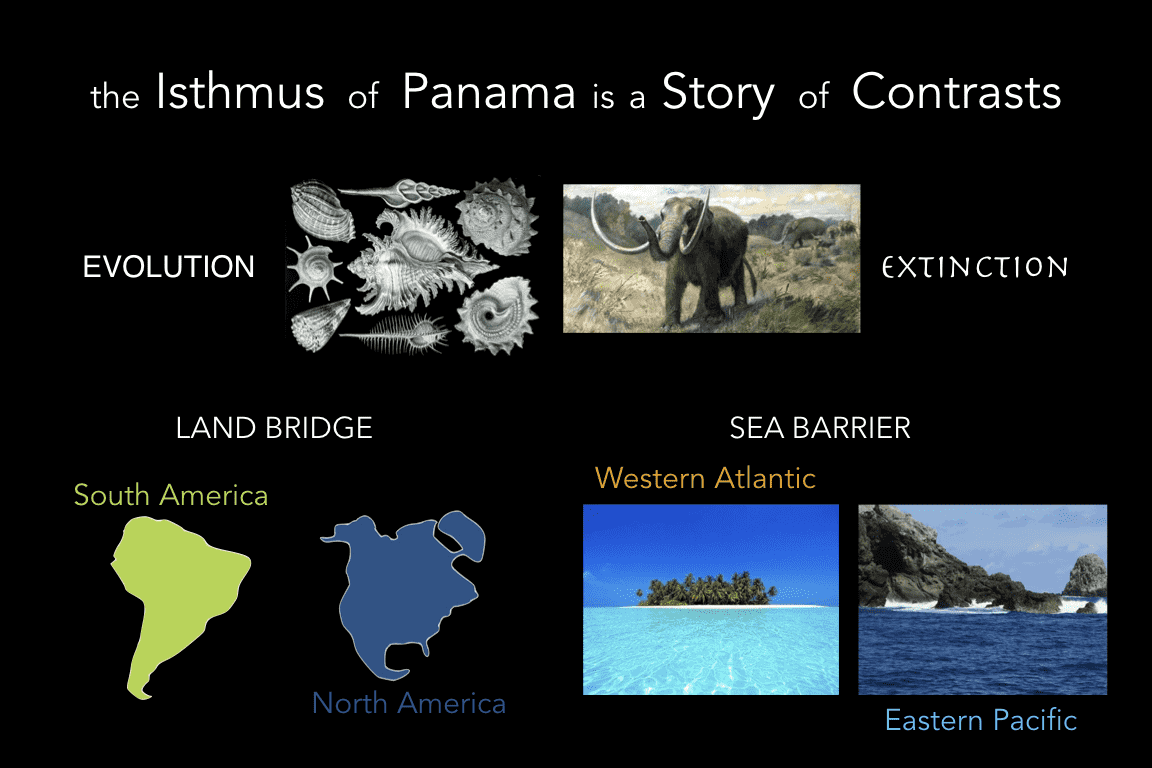class: center, middle, inverse, title-slide # A presentation about <br/> the Isthmus of Panama ## ⚔ ### ~ made by Jarrod J Scott ~ --- layout: true --- name: title class: center, bottom, inverse background-color: #000000 background-image: url(img/title.png) font-color: white background-size: contain background-position: center --- name: housekeeping class: center, middle, inverse background-color: #000000 font-color: white background-size: contain background-position: center # Housekeeping Press <font size=6em>`f`</font> for full screen mode. Press <font size=6em>`p`</font> to see the speaker notes where you can find more description of the slides. Press <font size=6em>`h`</font> or <font size=6em>`?`</font> to see the remark.js [keyboard shortcuts](https://bookdown.org/yihui/rmarkdown/xaringan-key.html). See the [Credits](#credits) section at the end for information about all of the things I used to make this presentation. The source code for the presentation is available on [<svg style="height:0.8em;top:.04em;position:relative;fill:white;" viewBox="0 0 496 512"><path d="M165.9 397.4c0 2-2.3 3.6-5.2 3.6-3.3.3-5.6-1.3-5.6-3.6 0-2 2.3-3.6 5.2-3.6 3-.3 5.6 1.3 5.6 3.6zm-31.1-4.5c-.7 2 1.3 4.3 4.3 4.9 2.6 1 5.6 0 6.2-2s-1.3-4.3-4.3-5.2c-2.6-.7-5.5.3-6.2 2.3zm44.2-1.7c-2.9.7-4.9 2.6-4.6 4.9.3 2 2.9 3.3 5.9 2.6 2.9-.7 4.9-2.6 4.6-4.6-.3-1.9-3-3.2-5.9-2.9zM244.8 8C106.1 8 0 113.3 0 252c0 110.9 69.8 205.8 169.5 239.2 12.8 2.3 17.3-5.6 17.3-12.1 0-6.2-.3-40.4-.3-61.4 0 0-70 15-84.7-29.8 0 0-11.4-29.1-27.8-36.6 0 0-22.9-15.7 1.6-15.4 0 0 24.9 2 38.6 25.8 21.9 38.6 58.6 27.5 72.9 20.9 2.3-16 8.8-27.1 16-33.7-55.9-6.2-112.3-14.3-112.3-110.5 0-27.5 7.6-41.3 23.6-58.9-2.6-6.5-11.1-33.3 2.6-67.9 20.9-6.5 69 27 69 27 20-5.6 41.5-8.5 62.8-8.5s42.8 2.9 62.8 8.5c0 0 48.1-33.6 69-27 13.7 34.7 5.2 61.4 2.6 67.9 16 17.7 25.8 31.5 25.8 58.9 0 96.5-58.9 104.2-114.8 110.5 9.2 7.9 17 22.9 17 46.4 0 33.7-.3 75.4-.3 83.6 0 6.5 4.6 14.4 17.3 12.1C428.2 457.8 496 362.9 496 252 496 113.3 383.5 8 244.8 8zM97.2 352.9c-1.3 1-1 3.3.7 5.2 1.6 1.6 3.9 2.3 5.2 1 1.3-1 1-3.3-.7-5.2-1.6-1.6-3.9-2.3-5.2-1zm-10.8-8.1c-.7 1.3.3 2.9 2.3 3.9 1.6 1 3.6.7 4.3-.7.7-1.3-.3-2.9-2.3-3.9-2-.6-3.6-.3-4.3.7zm32.4 35.6c-1.6 1.3-1 4.3 1.3 6.2 2.3 2.3 5.2 2.6 6.5 1 1.3-1.3.7-4.3-1.3-6.2-2.2-2.3-5.2-2.6-6.5-1zm-11.4-14.7c-1.6 1-1.6 3.6 0 5.9 1.6 2.3 4.3 3.3 5.6 2.3 1.6-1.3 1.6-3.9 0-6.2-1.4-2.3-4-3.3-5.6-2z"/></svg> Github ](https://github.com/istmobiome/istmobiome.github.io/tree/master/the-isthmus). I used the [xaringan](https://github.com/yihui/xaringan) package and referred a lot to this [amazing tutorial](https://arm.rbind.io/slides/xaringan.html#1). --- name: isthmus class: center, bottom, inverse background-color: #FFFFFF background-image: url(img/isthmus.png) font-color: white background-size: contain background-position: center ??? Roughly 3 million years ago, a spectacular natural experiment began when the Isthmus of Panama finally closed, a geologic process that began many million years earlier. On land, the formation of the Isthmus connected North & South America, and ushered in one of the greatest episode of migration in earth’s history— The Great American Biotic Interchange—Many of the mammal species we see today arrived during this event. However, what was a bridge on land became a barrier in the ocean. Where once a single tropical ocean flowed, two distinct marine environments formed when the Isthmus closed. Strikingly different physicochemical conditions persist in these two oceans today & these differences are reflected in the communities adapted to live there. So for marine organisms the story unfolded quite differently. The barrier separated populations, leading to speciation for some & local extinction for many others. --- name: contrasts1 class: center, bottom, inverse background-color: #000000 font-color: white background-size: contain background-position: center  --- name: contrasts1 background-color: #000000  ??? When I think about the formation of the Isthmus I think about the contrasting elements behind this events. For organisms the most important contrast is evolution and diversification vs. extinction and what drives these processes are the physical and geological changes that took place during the formation of the Isthmus. --- name: contrasts2 background-color: #000000  ??? Two continents, separated for more than 50my finally joined less than 3my ago. --- name: contrasts3 background-color: #000000  ??? On the other hand, one ocean split in two resulting in two vastly different marine environments. These contrasts form the backbone of this presentation but I would like you to keep this in Mind as you think about some of the topics we discuss tonight and your own experiences exploring panama. --- name: get-here class: inverse, center, middle # .large[How] did we get .large[here]? ??? So how did we get from one ocean to two, and from two continents to essentially one? In order to understand why the rise of the Isthmus was such an important event we must first understand what the stage looked like before this event. We’ll start by looking at continental drift and plate tectonics, because as you may know, land masses have not always been where they are today And they are always moving, albeit excrusiatilgy slow, over the earth’s mantle. And this movement is how we got to the isthmus. --- name: tectonics-sa class: center, bottom, inverse background-color: #FFFFFF background-image: url(img/tectonics.png) font-color: white background-size: contain background-position: center ??? As the theory goes, 225mya all 7 major continents and the Indian subcontinent were part of a supercontinent called Pangaea. Some 25my later this land mass began to split into two, Laurasia in the north comprising modern day Europe, North America and Asia And Gondwanaland in the south comprising S. America, Africa, Australia, Antarctica, and the Indian subcontinent. And by 100 mya S. America and Africa had completely separated from each other while N. America was still connected to Eurasia. SA remained connected with Ant and Aust. 50 mya Patagonia had many plant species that are now restricted to Australia meaning there Must have been a frost free corridor through Antarctica connecting SA and Australia. However by 40 mya but SA finally separated from ANT and AUST and for the next 35 million years was an island continent and the animals there—a mixture of Australian and Africa decent—evolved in complete isolation. --- name: tectonics-na class: center, bottom, inverse background-color: #FFFFFF background-image: url(img/tectonics.png) font-color: white background-size: contain background-position: center ??? The contrast with N. America was remarkable. During this same time NA was a larger continent intermittently connected to Eurasia (itself intermittently connected to Africa). Rather than evolving in isolation, N. A. Mammals were constantly tested by encounters with a wider variety of competitors. The result was a competitive advantage over their SA counterparts. As a result NA mammals spread widely, diversified greatly, and steadily replaced the many native SA animals after the land bridge formed. Although invaders crossed in both directions, SA mammals were much less successful. --- name: gene-flow class: center background-color: #FFFFFF font-color: black background-size: contain background-position: center .pull-left[  ] .pull-right[ ### The closure of the Isthmus of Panama formed a land .large[bridge] connecting South & North America. <br/> ### After 50 million years apart, a great biotic exchange took shape. ] ??? the formation of the Isthmus connected North & South America, and ushered in one of the greatest episode of migration in earth’s history— The Great American Biotic Interchange—Many of the mammal species we see today arrived during this eve --- name: land class: inverse, center, middle # .large[What] happened on .large[land]? --- name: land-1 class: center, bottom, inverse background-color: #FFFFFF background-image: url(img/land-1.png) font-color: white background-size: contain background-position: center ??? Ok, so lets take a look at the groups of mammals that migrated from South to North. We will focus on land mammals because the fossil record is much richer and easier to interpret but please remember that birds, plants, reptiles and insects also migrated across the new land bridge. --- name: land-2 class: center, bottom, inverse background-color: #FFFFFF background-image: url(img/land-2.png) font-color: white background-size: contain background-position: center ??? Its estimated that 19 groups of SA land mammals invaded NA. --- name: land-3 class: center, bottom, inverse background-color: #FFFFFF background-image: url(img/land-3.png) font-color: white background-size: contain background-position: center ??? Titanis large extinct flightless carnivorous bird. 3m, 150Kg Glyptodont extinct, heavily armored relatives of armadillos. roughly the size of a compact car Several extinct species of ground sloth one species 6m, 3000Kg. Went extinct 11000 years ago --- name: land-4 class: center, bottom, inverse background-color: #FFFFFF background-image: url(img/land-4.png) font-color: white background-size: contain background-position: center ??? The spectacled bear is the only bear native to South America and is the largest land carnivore on that part of the continent, although as little as 5% of its diet is composed of meat. South America's largest obligate carnivorous mammal is the jaguar (Panthera onca). Both from NA --- name: land-5 class: center, bottom, inverse background-color: #FFFFFF background-image: url(img/land-5.png) font-color: white background-size: contain background-position: center --- name: land-6 class: center, bottom, inverse background-color: #FFFFFF background-image: url(img/land-6.png) font-color: white background-size: contain background-position: center --- name: disperse-1 class: center, bottom, inverse background-color: #FFFFFF background-image: url(img/disperse-1.png) font-color: white background-size: contain background-position: center ??? Ok, so this is a graph showing the number of mammal genera migrating to and from each continent across time. The top panel shows the number of migrants from SA to NA, and the bottom from NA to SA. So for example if we look at the bar between 2 and 1 mya, we see that over 20 mammal groups went N to S and 3 went from S. To N. The main message here is that the vast majority of migrations occurred after 3mya suggesting that prior to this time there was no continuous passage. However we can also see that there are several instances of migrations before the proposed formation of the isthmus --- name: disperse-2 class: center, bottom, inverse background-color: #FFFFFF background-image: url(img/disperse-2.png) font-color: white background-size: contain background-position: center ??? Turns out that most of these early colonizers come from groups that are known for making oceanic voyages to settle in new lands. From SA… From NA… --- name: raft-1 class: center, bottom, inverse background-color: #FFFFFF background-image: url(img/raft-1.png) font-color: white background-size: contain background-position: center ??? In fact there are many well documented cases of this from recent times. (d) Tarentola geckos from Africa to Cuba; (f) monkeys (Platyrrhini) from Africa to South America; (i) chameleons three times from Madagascar to Africa; (j) several frog genera to and from Madagascar; But how do they do it? --- name: raft-2 class: center, bottom, inverse background-color: #000000 background-image: url(img/raft-2.png) font-color: white background-size: contain background-position: center ??? One idea is rafting on land that is dislodged during massive storms and swept out to sea. Sounds crazy, right? --- name: rafting class: center, middle, inverse font-color: white background-size: contain background-position: center <iframe width="965" height="543" src="https://www.youtube.com/embed/_OwfGunvPXA" frameborder="0" allow="accelerometer; autoplay; encrypted-media; gyroscope; picture-in-picture" allowfullscreen></iframe> ??? So this is a cell phone video taken in 2010 by the son of one of STRI’s scientists. This is the charges river where it flows into the Panama canal near Gamboa after an exceptionally large storm. The river is totally swole. The bridge that you will see by the way is over 100 years old. What you see are several large pieces of land moving downriver. --- name: sea class: inverse, center, middle # .large[What] happened in the .large[sea]? --- name: gene-flow-2 class: center background-color: #FFFFFF font-color: black background-size: contain background-position: center .pull-left[ ### The closure of the Isthmus of Panama formed a .large[barrier] between the Western Atlantic & Eastern Pacific. <br/> ### Where once a single ocean flowed, two vastly different marine environments emerged & genetic exchanged ceased. ] .pull-right[  ] ??? As I mentioned at the start what happened in the sea was very different compared to what happened on land. Here the bridge became a barrier effectively cutting off all gene flow between once connected populations and causing local extinction of many species. --- name: closure-1 class: center, bottom, inverse background-color: #000000 background-image: url(img/close-1.png) font-color: white background-size: contain background-position: center ??? At the start of the Micocene ~20 mya a common marine assemblage of plants and animals extended from western Mexico and Ecuador in the Pacific to Trinidad and Cuba in the Atlantic thanks to deep water connections between N. And S. America. This biota evolved independently from that in the Indo-Pacific, an area encompassing tropical waters stretching from Hawaii through Aust., Indonesia, and India, all the way to the E. Coast of africa. --- name: closure-2 class: center, bottom, inverse, animated, fadeIn background-color: #000000 background-image: url(img/close-2.png) font-color: white background-size: contain background-position: center ??? By 12 mya the land bridge was almost complete possibly allowing some small scale interchange between N and SA. At this time the isthmus was a peninsula of NA yet a deep water passage still existed between N and SA. --- name: closure-3 class: center, bottom, inverse, animated, fadeIn background-color: #000000 background-image: url(img/close-3.png) font-color: white background-size: contain background-position: center ??? Around 6 mya the rising Isthmus began splitting deeper water populations of marine organisms. We will talk about a really cool example of this in a minute. Sea temperatures and salinity began rising in the Caribbean but not the Pacific --- name: closure-4 class: center, bottom, inverse, animated, fadeIn background-color: #000000 background-image: url(img/close-4.png) font-color: white background-size: contain background-position: center ??? And by 4mya the narrowing seaway began to diminish Caribbean upwelling and the final closure extinguish upwelling in the caribbean. Turns out that Seasonal upwelling plays an important role in this part of the story. So lets talk about this for a minute --- name: upwelling class: center, top, inverse background-color: #000000 background-image: url(img/upwelling.png) font-color: white background-size: contain background-position: center ### Caused seasonal Upwelling in the Eastern Pacific. ??? Upwelling is an oceanographic phenomenon that involves wind-driven motion that moves away warmer, usually nutrient-depleted surface water, allowing dense, cooler, and usually nutrient-rich deeper water towards the ocean surface. The nutrient-rich upwelled water stimulates the growth and reproduction of primary producers such as phytoplankton—single celled plants that float in the upper water column and use sunlight to generate oxygen and fix carbon dioxide that is used by animals further up the food chain. --- name: map class: center, top, inverse background-color: #000000 background-image: url(img/map.png) font-color: white background-position: center ??? In Panama, seasonal winds move from North to South especially in the east where mountains are relatively low causing upwelling in the bay of Panama The nutrient-rich upwelled water stimulates the growth and reproduction of primary producers such as phytoplankton—single celled plants that float in the upper water column and use sunlight to generate oxygen and fix carbon dioxide that is used by animals further up the food chain. During upwelling events temperatures can drop by up to 10C --- name: gene-flow-2 class: center, top,inverse background-color: #000000 font-color: white background-size: contain background-position: center .pull-left[ <br/> ### .orange[Western Atlantic] <br/> <br/> <br/> <br/> .large[smaller tidal range] .large[no seasonal upwelling] .large[low nutrients] .large[stable water temperature] ] .pull-right[ <br/> ### .blue[Eastern Pacific] <br/> <br/> <br/> <br/> .large[greater tidal range] .large[seasonal upwelling] .large[high nutrients] .large[variable water temperature] ] <br/> <br/> ### .Large[.center[.bottom[Physical Contrasts]]] ??? Now lets take a look at some of the broad contrasting physical conditions that developed in these new oceans and some of the general biological consequences that resulted. Here in Bocas we barely pay attention to the tides but in the bay of Panama tidal ranges can be up to 6m --- name: tide-1 class: center, bottom, inverse background-color: #000000 background-image: url(img/tide-1.png) font-color: white background-position: center --- name: tide-2 class: center, bottom, inverse, animated, fadeIn, slow background-color: #000000 background-image: url(img/tide-2.png) font-color: white background-position: center --- name: tide-3 class: center, bottom, inverse, animated, fadeIn background-color: #000000 background-image: url(img/tide-3.png) font-color: white background-size: contain background-position: center --- name: exposed-1 class: center, bottom, inverse, animated, fadeIn background-color: #000000 background-image: url(img/exposed.png) font-color: white background-size: contain background-position: center --- name: exposed-2 class: center, bottom, inverse, animated, fadeIn background-color: #000000 background-image: url(img/mangrove.png) font-color: white background-size: contain background-position: center --- name: upwelling-2 class: center, bottom, inverse, animated, fadeIn background-color: #000000 background-image: url(img/upwelling-2.png) font-color: white background-size: contain background-position: center --- name: benthic class: center, bottom, inverse, animated, fadeIn background-color: #000000 background-image: url(img/benthic.png) font-color: white background-size: contain background-position: center ??? small ahermatypic corals died out while hermatypic corals expanded Free-swimming molluscs died out while molluscs that live in reefs flourished Filter-feeding molluscs died out while predatory and herbivorous molluscs became more abundant. Also WA has abundant seagrass beds --- name: ep-change class: left, top,inverse background-color: #000000 font-color: white background-size: contain background-position: center <br/> ### .center[How did the Isthmus change the .blue[EP?]] <br/> <br/> <br/> <br/> .large[reef building coral went extinct] .large[recolonized from Indo-Pacific] .large[coral reefs are small] .large[restricted to shallow water (< 10 m)] .large[limited to sheltered situations] .large[lower abundance & diversity of sponges/CCA] --- name: ep-change class: center, middle,inverse background-color: #000000 font-color: white background-size: contain background-position: center # Sister species that survived <br/>the formation of the Isthmus --- name: gunther class: center, bottom, inverse background-color: #000000 background-image: url(img/gunther.png) font-color: white background-size: contain background-position: center --- name: darwin class: center, bottom, inverse background-color: #000000 background-image: url(img/darwin.png) font-color: white background-size: contain background-position: center --- name: geminates class: center, bottom, inverse background-color: #FFFFFF background-image: url(img/geminates.png) font-color: white background-size: contain background-position: center --- name: shrimp class: center, bottom, inverse background-color: #000000 background-image: url(img/shrimp.png) font-color: white background-size: contain background-position: center --- name: slugs class: center, bottom, inverse background-color: #000000 background-image: url(img/slugs.png) font-color: white background-size: contain background-position: center --- name: summary class: center, bottom, inverse background-color: #FFFFFF background-image: url(img/summary.png) font-color: white background-size: contain background-position: center --- name: ep-change class: center, middle,inverse background-color: #000000 font-color: white background-size: contain background-position: center # And that is how the Isthmus of Panama <br/>changed the world. the end --- name: credits class: left, middle background-color: #F2F2F2 font-color: #191919 background-size: contain background-position: center # Credits & Resources Find the source code for the presentation here [<svg style="height:0.8em;top:.04em;position:relative;" viewBox="0 0 496 512"><path d="M165.9 397.4c0 2-2.3 3.6-5.2 3.6-3.3.3-5.6-1.3-5.6-3.6 0-2 2.3-3.6 5.2-3.6 3-.3 5.6 1.3 5.6 3.6zm-31.1-4.5c-.7 2 1.3 4.3 4.3 4.9 2.6 1 5.6 0 6.2-2s-1.3-4.3-4.3-5.2c-2.6-.7-5.5.3-6.2 2.3zm44.2-1.7c-2.9.7-4.9 2.6-4.6 4.9.3 2 2.9 3.3 5.9 2.6 2.9-.7 4.9-2.6 4.6-4.6-.3-1.9-3-3.2-5.9-2.9zM244.8 8C106.1 8 0 113.3 0 252c0 110.9 69.8 205.8 169.5 239.2 12.8 2.3 17.3-5.6 17.3-12.1 0-6.2-.3-40.4-.3-61.4 0 0-70 15-84.7-29.8 0 0-11.4-29.1-27.8-36.6 0 0-22.9-15.7 1.6-15.4 0 0 24.9 2 38.6 25.8 21.9 38.6 58.6 27.5 72.9 20.9 2.3-16 8.8-27.1 16-33.7-55.9-6.2-112.3-14.3-112.3-110.5 0-27.5 7.6-41.3 23.6-58.9-2.6-6.5-11.1-33.3 2.6-67.9 20.9-6.5 69 27 69 27 20-5.6 41.5-8.5 62.8-8.5s42.8 2.9 62.8 8.5c0 0 48.1-33.6 69-27 13.7 34.7 5.2 61.4 2.6 67.9 16 17.7 25.8 31.5 25.8 58.9 0 96.5-58.9 104.2-114.8 110.5 9.2 7.9 17 22.9 17 46.4 0 33.7-.3 75.4-.3 83.6 0 6.5 4.6 14.4 17.3 12.1C428.2 457.8 496 362.9 496 252 496 113.3 383.5 8 244.8 8zM97.2 352.9c-1.3 1-1 3.3.7 5.2 1.6 1.6 3.9 2.3 5.2 1 1.3-1 1-3.3-.7-5.2-1.6-1.6-3.9-2.3-5.2-1zm-10.8-8.1c-.7 1.3.3 2.9 2.3 3.9 1.6 1 3.6.7 4.3-.7.7-1.3-.3-2.9-2.3-3.9-2-.6-3.6-.3-4.3.7zm32.4 35.6c-1.6 1.3-1 4.3 1.3 6.2 2.3 2.3 5.2 2.6 6.5 1 1.3-1.3.7-4.3-1.3-6.2-2.2-2.3-5.2-2.6-6.5-1zm-11.4-14.7c-1.6 1-1.6 3.6 0 5.9 1.6 2.3 4.3 3.3 5.6 2.3 1.6-1.3 1.6-3.9 0-6.2-1.4-2.3-4-3.3-5.6-2z"/></svg>](https://github.com/istmobiome/istmobiome.github.io/tree/master/the-isthmus). Slides created with the R package [xaringan](https://github.com/yihui/xaringan). Most of the raw material for this presentation was courtesy of [Dr. Aaron O'Dea](https://odealab.com/). <br/> I also drew heavily from these publication for much of the framework for the presentation. - O'Dea et al. (2016) *Formation of the Isthmus of Panama*. [Science Advances 2:e1600883](https://doi.org/10.1126/sciadv.1600883). - Alan de Queiroz (2005) *The resurrection of oceanic dispersal in historical biogeography* [Trends in Ecology & Evolution 20: 68-73](https://doi.org/10.1016/j.tree.2004.11.006). - Leigh et. al. (2013) *Historical biogeography of the Isthmus of Panama* [Biological Reviews 89:148-172](https://doi.org/10.1111/brv.12048). - Lessios (2008) *The Great American Schism: Divergence of Marine Organisms After the Rise of the Central American Isthmus* [Annual Review of Ecology, Evolution, and Systematics 39:63-91](https://doi.org/10.1146/annurev.ecolsys.38.091206.095815).